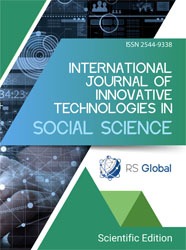PARADOXES AT LEXICAL, SYNTACTIC, AND TEXTUAL LEVELS
Abstract
The presented article aims to study the problem of contradictory concepts, ideas by discussing oxymoron and antithesis, to give an outline of these very important and frequently used stylistic devices, their peculiarities and classification; also, to identify those new classes which were revealed after meticulously studying the material under investigation. Exactly these classes are the novelty that is suggested in the given article. Besides, the article studies contradictory themes developed in the text what we call a textual paradox.
References
Akhtyrska K. Linguistic Expression of Irony in Social Media. Dissertation for obtaining a Master's Degree in Language Sciences. University of Algarve, Portugal. 2014.
Belle, H. van. Playing with Oppositions. Verbal and visual antithesis in the media. Argument Cultures: Proceedings of OSSA 2009, Windsor, pp. 1-13.
Herrero J. Understanding Tropes: At the Crossroads between Pragmatics and Cognition. Frankfurt: Peter Lang. 2009.
Jeffries L, McIntyre D. Stylistics. New York: Cambridge University Press, 2010.
Kemertelidze N., Manjavidze T. Stylistic Repetition, Its Peculiarities and Types in Modern English. European Scientific Journal. Special Edition. 2013, pp. 1-8.
Krippendorff, K. (2007). Design Research, an Oxymoron? Design Research Now: Essays and selected projects. Zürich: Birkhäuser Verlag. 2007, pp. 67-80.
Sakaeva L.R., Kornilova L.A. Structural Analysis of the Oxymoron in the Sonnets of William Shakespeare. Journal of History Culture and Art Research 6(5):409. 2017.
Simpson P. Stylistics. London: Routledge Taylor & Francis Group. 2011.
Yemets A. Pragmatic and Stylistic Aspects of Expressing Tolerance in Modern American Short Stories. Accents and Paradoxes of Modern Philology, Issue 1-2018 (3), pp. 88–98.
Zhirenov S., Dauletbekjva Zh., Koblanova A., Kokanova Zh., Rauandina A. The Cognitive Nature of Lexical Units Having Opposite Meaning in Linguistics. World Applied Sciences Journal 36 (2). 2018, pp. 213-222.
Views:
436
Downloads:
310
Copyright (c) 2020 The authors

This work is licensed under a Creative Commons Attribution 4.0 International License.
All articles are published in open-access and licensed under a Creative Commons Attribution 4.0 International License (CC BY 4.0). Hence, authors retain copyright to the content of the articles.
CC BY 4.0 License allows content to be copied, adapted, displayed, distributed, re-published or otherwise re-used for any purpose including for adaptation and commercial use provided the content is attributed.











